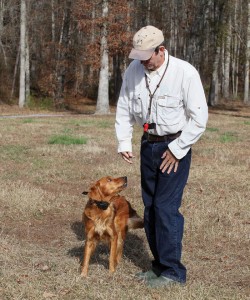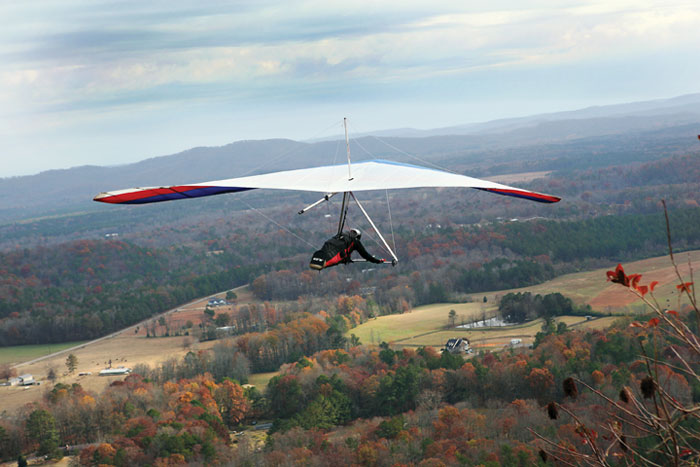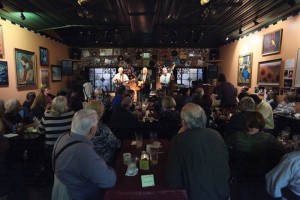Rural paradise, Kelly Run Farm, known far and wide for breeding, training retrievers
Story by Carol Pappas
Photos by Jerry Martin
It is one of those hidden-away places that you just might miss if you weren’t looking for it. But find the gated dirt road leading to Kelly Run Farm, round the bend and you come face-to-face with a rustic paradise.
A log home, wide-open pasture and ponds against a backdrop of towering trees make an ideal setting for Clarke and Dyxie Pauly, who wanted to get away from the harried pace of big-city life and pursue their passion for dogs.
To the Paulys, the land is their paradise. To their four-legged friends — some they own; some simply guests in their boarding operation — the land is their heaven.
Clarke Pauly has built a national reputation on this 30-acre tract that lies between Pell City and Odenville, breeding and training field Golden Retrievers. On a recent visit to Kelly Run Farm, named for the creek that runs nearby, the Paulys were playing host to two litters of Golden Retrievers, 13 in all. Theirs was a seven-week stay before moving on to points across the country, filling the wish lists of hunters and dog lovers and to be used as guide dogs in two instances.
 The 9-puppy litter belonged to Taz, the Paulys’ 4-year-old field dog, and Mr. D.J. from Tennessee, who is a confirmation or show dog. It was the Paulys’ first attempt at breeding these distinctly different types of Golden Retrievers, but the result was nothing short of an absolute cuteness guaranteed to evoke a smile from all who see them. “They came out real pretty,” said Clarke, who had his hands full trying to get nine scurrying puppies to pause a moment to look in the direction of a camera.
The 9-puppy litter belonged to Taz, the Paulys’ 4-year-old field dog, and Mr. D.J. from Tennessee, who is a confirmation or show dog. It was the Paulys’ first attempt at breeding these distinctly different types of Golden Retrievers, but the result was nothing short of an absolute cuteness guaranteed to evoke a smile from all who see them. “They came out real pretty,” said Clarke, who had his hands full trying to get nine scurrying puppies to pause a moment to look in the direction of a camera.
Rebel, the Paulys’ 9-year-old, and Sky from Florida are true field dogs, and they are the parents of the 4-puppy litter. “They are true working dogs,” Clarke said. But at this moment, they’re just plain puppies, exploring everything around them.
At 5 and 6 weeks, he had them out touring the property, getting them used to all types of topography. “That way, nothing really scares them. They’re used to all terrains,” Dyxie noted.
While the puppies have been an enjoyable diversion at Kelly Run Farm, it’s the business of boarding dogs and training Golden Retrievers that keeps the Paulys the busiest.
When they moved to St. Clair County in December of 1999, it was to have just the right place to train dogs. Clarke began training after Dyxie’s Golden Retriever went jogging with him back in Birmingham. “She would stay to my left and I thought, ‘That’s cool.’ ” He began to do more and more and then started training dogs in city parks but soon found they weren’t ideal for his newfound hobby. “When the police were called on us, I knew it wasn’t working,” he said.
They began a search for just the right property and just as visitors do today, they rounded the bend and came face to face with their dream home.
“We always wanted a log home,” Dyxie recalled. One Labor Day, they saw an ad that said: “Log home with 20 acres.”
“It had to be just so,” Clarke said, remembering a mental checklist he had made for the perfect place before their arrival. “We couldn’t see it from the road.” But when they turned in, “both of us looked at each other and said, ‘Wow!’ It had a swamp. Every criteria was met. It was like the list. We built the ponds the way we wanted. It was just our dream house,” Clarke said.
“It was meant to be,” Dyxie said, echoing the sentiment.
And it has been. The Paulys have been partnering with Jackie Mertens of Topbrass Retrievers in Madison, Fla., on the training side of the business virtually ever since. “We raise. She markets. If you want field Goldens, Jackie’s the woman to see,” Clarke said.
On the boarding side, it was a business that eventually evolved. “We had enough runs for our dogs, but friends kept asking, ‘Can you keep my dog?’ We thought it was a good idea. In 2003, we started boarding,” Dyxie said.
 Today, they can board up to 52 dogs at one time, and more than 1,000 clients have entrusted their dogs’ care at Kelly Run Farm, almost a doggie day camp with room to roam, exercise, play and swim. Among their more famous guests was a Golden Retriever who played “Duke” on the Bush’s Beans commercials three years running. In the commercials, Duke is the talking dog who tries to sell the secret family recipe for the highly successful line of beans.
Today, they can board up to 52 dogs at one time, and more than 1,000 clients have entrusted their dogs’ care at Kelly Run Farm, almost a doggie day camp with room to roam, exercise, play and swim. Among their more famous guests was a Golden Retriever who played “Duke” on the Bush’s Beans commercials three years running. In the commercials, Duke is the talking dog who tries to sell the secret family recipe for the highly successful line of beans.
No fear, he didn’t sell the recipe on any of his trips to Kelly Run, but his owners did thank Clarke and Dyxie for hosting their star with a special, framed photograph sequence of their boarder of notoriety in some of the advertisements in which he appeared.
Others may not be as famous, but they are no less loved. It is evident from the moment you step onto the property. And that love carries over to the discipline of training dogs.
Clarke agrees to demonstrate years worth of work in training Taz and Rebel, whose playful personalities come out as they jump and run, circling Clarke and making them look like any other dog who loves the attention of their master. But when it’s time to go to ‘work,’ their keen focus is all on Clarke and the job at hand.
On this particular afternoon, Clarke demonstrates the hunt for a downed bird. A gunshot sounds. Taz is more than ready to take off, but she doesn’t. She is at complete attention — like a statue at Clarke’s side. He sounds a short whistle, and she is off and running like a strong gust of wind. Another whistle sounds, and the abruptness of the stop is amazing. She turns, faces Clarke and sits. With a hand motion to the left from Clarke, the gust catches hold again, and she speedily heads directly toward her prey. She can’t see it, but the whistles and the motions from Clarke telegraph the exact location to her.
She runs into the woods and in a moment or so, she heads back with the prize from the woods and the praise awaiting her from Clarke a hundred yards away.
It’s just another day at Kelly Run Farm, where a dog’s life truly is the good life. And in return, the Paulys enjoy the good life, too. Nothing tells that story quite as well their own words in “About Us” on their website.
Here’s a hint, the title reads: “About Us (and the dogs that own us).”




























































































